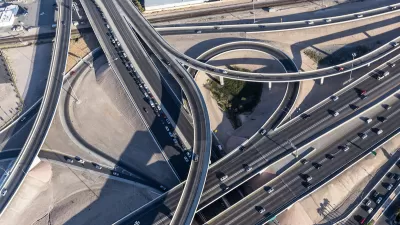The Economist looks at the looming battle between Congress and the Administration over whether to proceed now on transportation reauthorization or delay it 18 months, and concludes that the bottom line will be the funding mechanism.
Despite differences between House Committee on Transportation and Infrastructure Chair James Oberstar and DOT Secretary LaHood, there is hope that the new bill will be an improvement over the current one. Key, though, will be how to pay for it. Agreeing how to fill the broke Highway Trust Fund is central to the bill.
"Now a strategy is emerging at last. Mr. Oberstar would spend $450 billion on roads, bridges and mass transport, 38% above current levels, and devote $50 billion to high-speed rail.
Such ambitious plans, however, may have to be postponed. Mr. LaHood wants to extend the old transport bill by 18 months. Even without a new bill, there may be room for progress, says a hopeful James Corless of Transportation for America, a reform group. The transport secretary says he would send more money to metropolitan areas and use cost-benefit analyses to guide investment. The DoT is already encouraging plans to build housing near transport, expand access to buses, subways and bicycles, and reduce emissions in the process.
Still, a main question remains unanswered. The Highway Trust Fund will soon be empty. There is no consensus on how to fill it. The gas (petrol) tax, the main source of revenue for transport, has remained flat since 1993. Revenues have declined as travel has ebbed in the recession and cars have become more efficient. In the long term, congestion pricing is the best solution, but it could take years to adopt. In the meantime the Obama administration is loth to raise the gas tax. Siphoning money from general funds is an easy but unsustainable answer. There may be a new vision for transport, but it will never progress until someone is willing to pay for it."
Thanks to Bay Area Transportation News
FULL STORY: Ambitious plans for American transport run into reality

Maui's Vacation Rental Debate Turns Ugly
Verbal attacks, misinformation campaigns and fistfights plague a high-stakes debate to convert thousands of vacation rentals into long-term housing.

Planetizen Federal Action Tracker
A weekly monitor of how Trump’s orders and actions are impacting planners and planning in America.

In Urban Planning, AI Prompting Could be the New Design Thinking
Creativity has long been key to great urban design. What if we see AI as our new creative partner?

King County Supportive Housing Program Offers Hope for Unhoused Residents
The county is taking a ‘Housing First’ approach that prioritizes getting people into housing, then offering wraparound supportive services.

Researchers Use AI to Get Clearer Picture of US Housing
Analysts are using artificial intelligence to supercharge their research by allowing them to comb through data faster. Though these AI tools can be error prone, they save time and housing researchers are optimistic about the future.

Making Shared Micromobility More Inclusive
Cities and shared mobility system operators can do more to include people with disabilities in planning and operations, per a new report.
Urban Design for Planners 1: Software Tools
This six-course series explores essential urban design concepts using open source software and equips planners with the tools they need to participate fully in the urban design process.
Planning for Universal Design
Learn the tools for implementing Universal Design in planning regulations.
planning NEXT
Appalachian Highlands Housing Partners
Mpact (founded as Rail~Volution)
City of Camden Redevelopment Agency
City of Astoria
City of Portland
City of Laramie





























